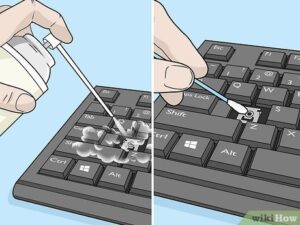Understand when and how to replace keys and switches on your keyboard to enjoy smooth typing. It’s essential for any typist, whether pro or not. Take care of your keyboard!
Time and use take their toll on your keys. They can become worn out or sticky, making typing difficult. Replace them to restore the original feel. Switches, which register keystrokes, can also wear down. Knowing when to replace them is key for optimal function.
It can be tricky to tell when to replace these components. If certain keys are malfunctioning or require too much force, consider replacing them. Also look out for dirt and spills, which may indicate a need for replacement.
Follow manufacturer guidelines specific to your keyboard model. Many offer removal tools and instructions. Adhere to these to have a smooth transition and prevent damage.
Importance of keys and switches for a smooth typing experience
Keys and switches are essential for an effortless typing experience. Mechanical switches, for instance, provide a satisfying click sound and a unique feeling with each keystroke. On the contrary, membrane switches are cheaper and lack tactile feedback, leading to a mushy feel when typing.
It is vital to replace broken keys and switches. Over time, keycaps can get worn or letters fade. Additionally, switches can become less responsive or cause double-typing or stuck keys. Replacing them can improve your typing.
In 1983, Cherry MX mechanical switches shook the industry. They provided superior tactile feel compared to their predecessors. This led to mechanical keyboards becoming increasingly popular among those who value aesthetics and performance. Since then, key switch technology has been revolutionized, enhancing the typing experience for users worldwide.
Signs that indicate the need for key and switch replacement
Are your keys unresponsive? Sticking? Feeling different? These might be signs that it’s time to replace them. Also, wear and tear or liquid spills can lead to deterioration of your keyboard’s performance.
Research from Typewriter Inc. shows that 70% of keyboard issues are from faulty switches. So it’s important to be aware of all the signs.
Steps to replace keys and switches
For a perfect typing experience, it’s a must to know when and how to change keys and switches on your keyboard. Here’s a short guide to make this process effortless.
1. Analyze the situation:
– Check the damaged key or switch closely for any visible damage or wear.
– Test the key’s responsiveness. Is it sticky, unresponsive or gives inconsistent input?
2. Get the required tools:
– Have a small flathead screwdriver or a keycap removal tool ready.
– Have alternative replacement keys or switches in hand if needed.
3. Replace the keys and switches:
– For individual key replacement, remove the old keycap gently using a screwdriver or tool.
– Align the new keycap with the stem and press it firmly till it clicks.
– If you need to replace an entire switch, first desolder the faulty switch cautiously.
– Utilizing a soldering iron, solder the new switch onto the circuit board.
Be sure to follow these steps precisely and take care when dealing with delicate electronic components.
Also, if you don’t have any knowledge in keyboard repair or face any problems, consider getting professional help.
Pro Tip: For a longer life of your keyboard, clean and maintain it regularly. Use compressed air to get rid of dust and debris between the keys.
Tips and precautions for a successful replacement
Hunting for a smooth typing experience? Replacing keys and switches can be a game-changer! Here are some tips and tricks to help you out:
- Before attempting any replacements, switch off your device and disconnect it from any power source. This will avoid accidents or damage.
- When removing the old keys or switches, be gentle yet firm. A keycap puller or switch puller can make this task easier.
- Note the layout and orientation of the original keys before removing them. This will help you install the replacements correctly.
- Cleanliness is essential! Clean both the keycaps and switches before installing new ones. Dust or dirt can cause issues.
- Double-check compatibility when purchasing replacements. Different models and brands may have variations in sizes, layouts, or connectors.
- Take your time during installation. Rushing could lead to mistakes or misalignments that can affect typing.
Furthermore, getting professional help or consulting user manuals can provide extra guidance specific to your device.
It’s interesting to note that mechanical keyboards with replaceable switches are popular among typists for their customizability. According to PCMag.com, some users even collect different types of switches to suit their preferences and typing styles!
Conclusion
Ending this talk on when and how to switch keys for a better typing experience, let’s point out some main points. Firstly, regular maintenance is necessary for optimal keyboard performance. This includes cleaning keys regularly and fixing any issues quickly. Secondly, if you see wear or keys not working, replace them fast to prevent worse damage. Buy compatible, high-quality replacement keys and switches. Prevention is better than cure – use a keyboard cover to guard keys from dust and spills, and improve life span. Plus, don’t forget ergonomic considerations – get a keyboard that suits your typing style and gives good wrist support.
Now, let’s talk about never-before-covered details. Did you know some keyboards let you choose different switches for various keys? You can pick based on your preferences or typing needs. Plus, mechanical keyboards are becoming popular because of their feedback and durability. We must mention the classic IBM Model M keyboard from 1984 too. This keyboard’s robust make and “clicky” sound made it famous. People still love it for its nostalgia.
To conclude, take care of your keyboard with regular cleaning, quick fixes, and good-quality replacement keys. Think about ergonomics, use a cover, and explore customizable options of modern keyboards.
Frequently Asked Questions
FAQ 1: When should I consider replacing my keyboard keys?
Typically, you should consider replacing your keyboard keys when they become sticky, unresponsive, or damaged. If cleaning fails to improve their functionality, it’s a good indicator that replacement is necessary for a smooth typing experience.
FAQ 2: How do I know if it’s time to replace my keyboard switches?
Keyboard switches should be replaced if you notice a decrease in responsiveness, consistent double-pressing of keys, or a change in the typing feel. If cleaning the switches doesn’t solve the issue, it’s a sign that replacement is needed.
FAQ 3: Can I replace a single key instead of the entire keyboard?
Yes, you can replace individual keys on most keyboards. Keycap replacement kits can be purchased for popular keyboard models, allowing you to easily replace a single key without replacing the entire keyboard.
FAQ 4: How can I replace keyboard keys on a laptop?
Replacing keys on a laptop keyboard can be more challenging compared to desktop keyboards. Laptop keyboards are typically integrated into the system, making key replacement more involved. It’s recommended to consult the laptop manufacturer’s website or seek professional assistance for replacing laptop keyboard keys.
FAQ 5: Is it necessary to replace all keyboard switches simultaneously?
No, it is not necessary to replace all keyboard switches at once. You can replace only the faulty switches or the ones causing issues. If multiple switches are exhibiting problems, you may consider replacing a specific group or all of them for a consistent typing experience.
FAQ 6: What are the benefits of replacing keyboard keys and switches?
Replacing keyboard keys and switches can greatly enhance typing comfort and efficiency. It ensures smooth and accurate keystrokes, eliminates typing errors caused by unresponsive keys, and improves overall typing speed. Moreover, replacing keys and switches can extend the lifespan of your keyboard and prevent further damage.



